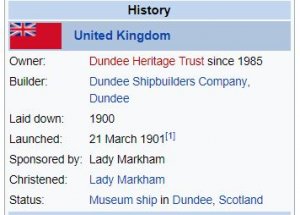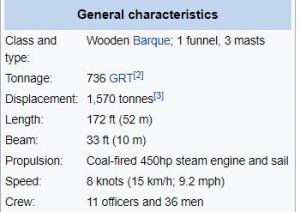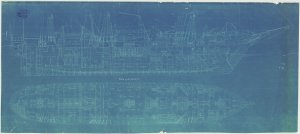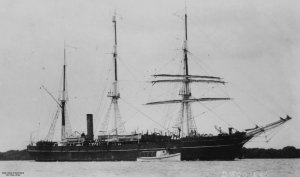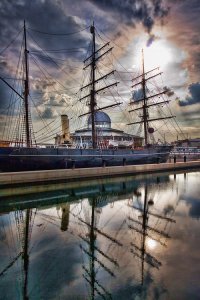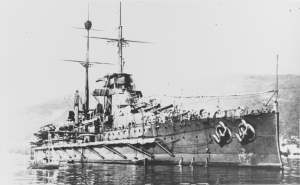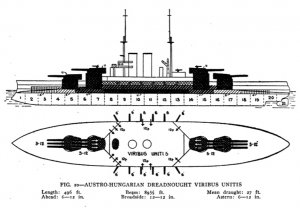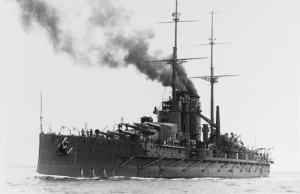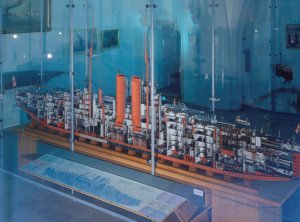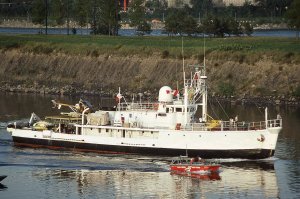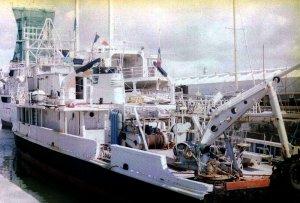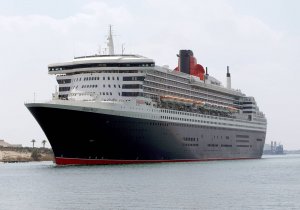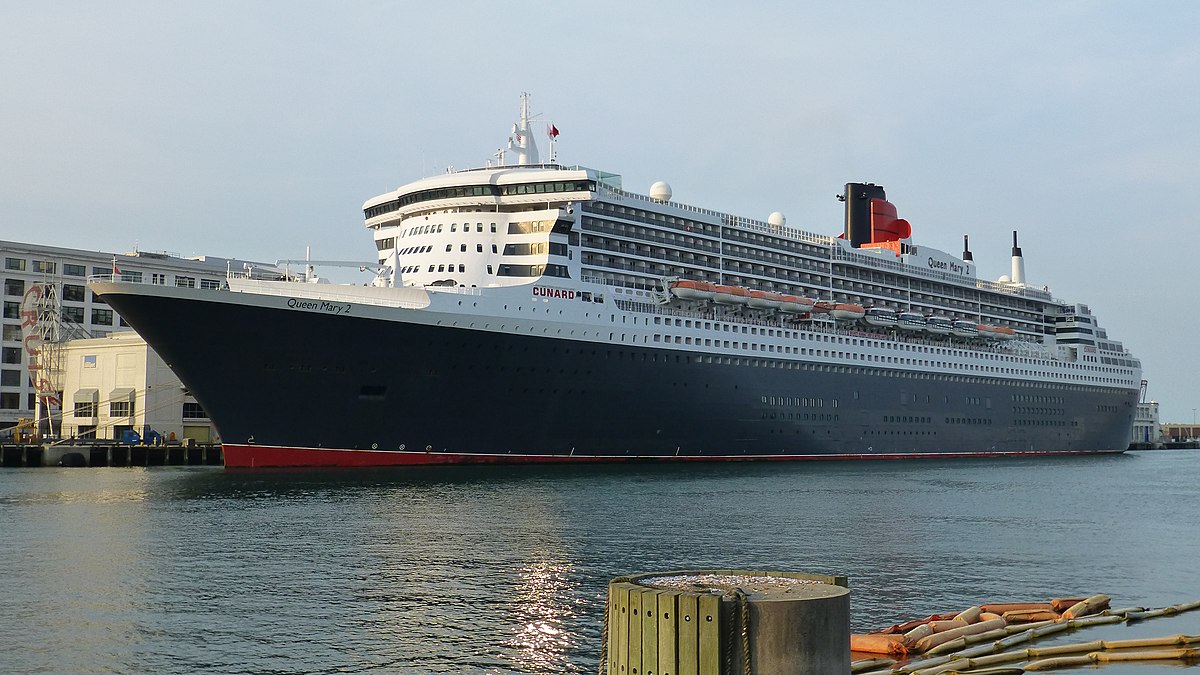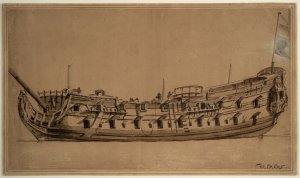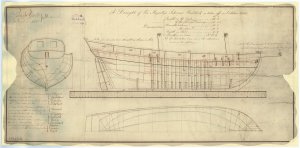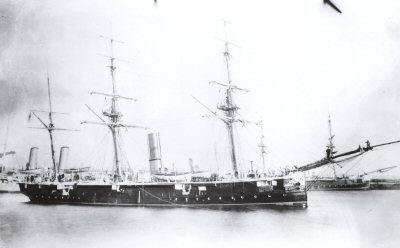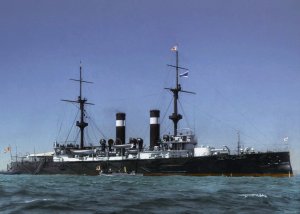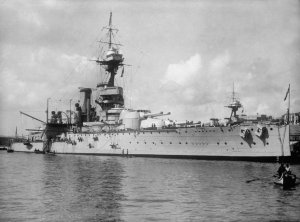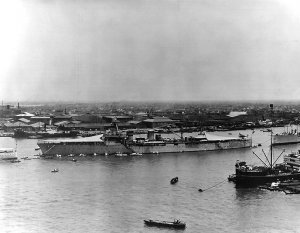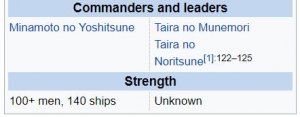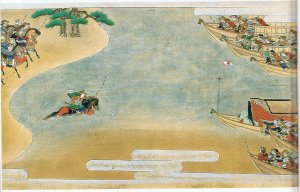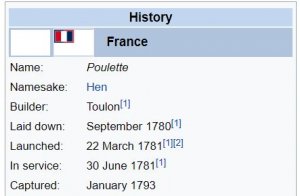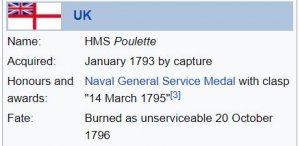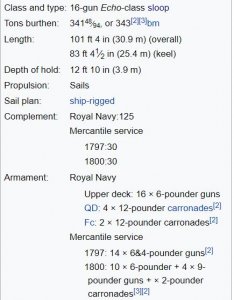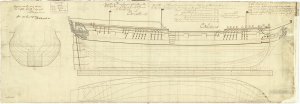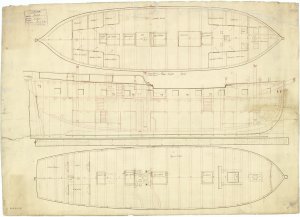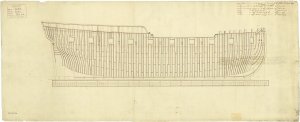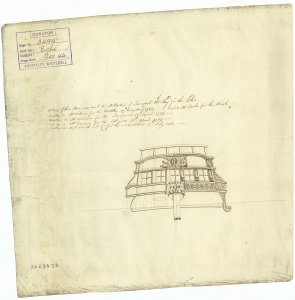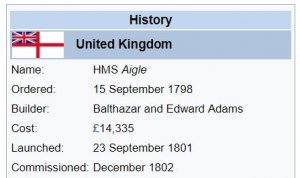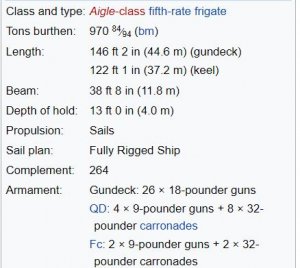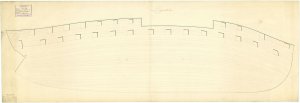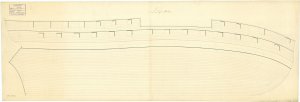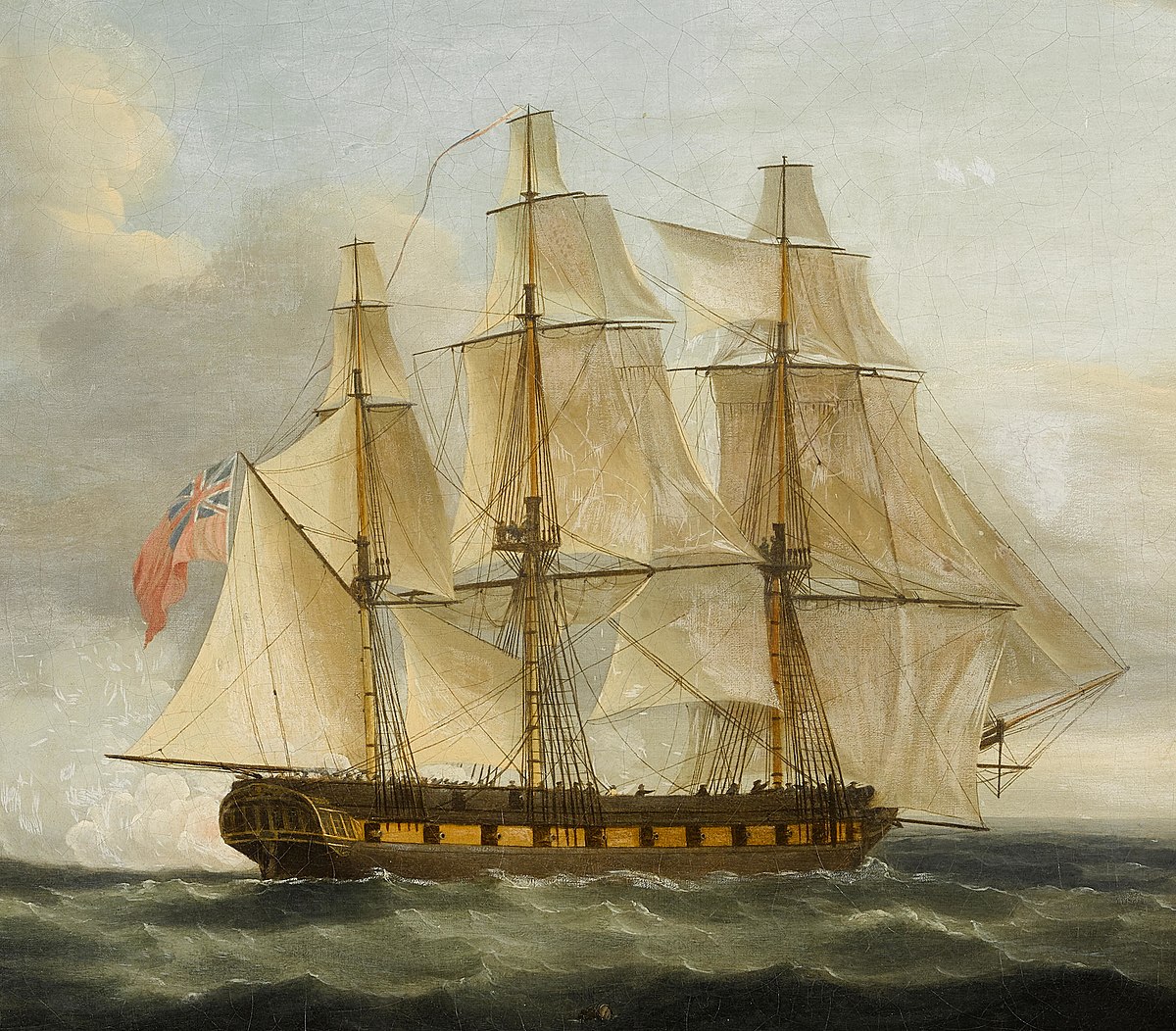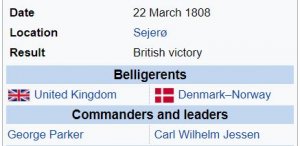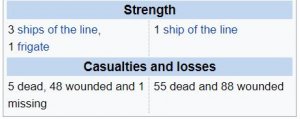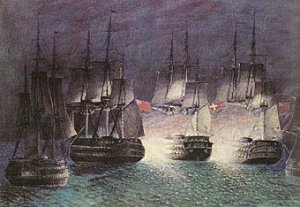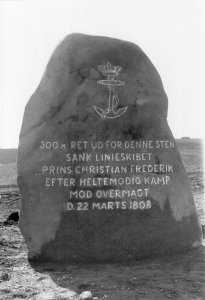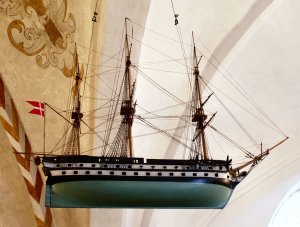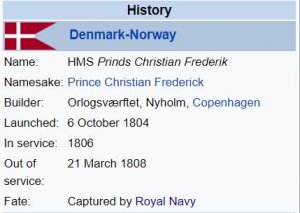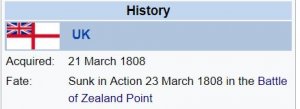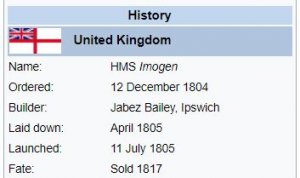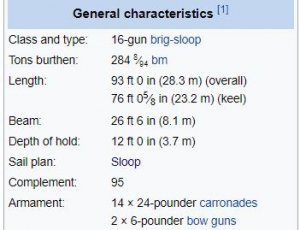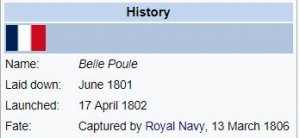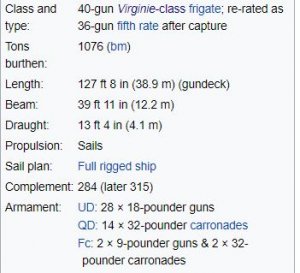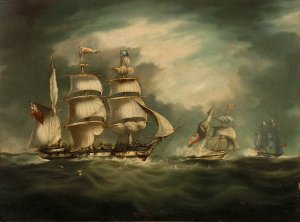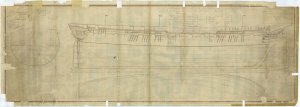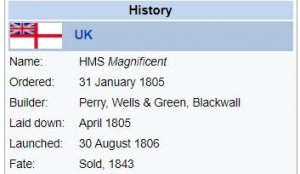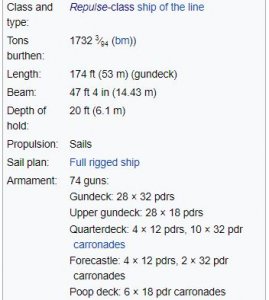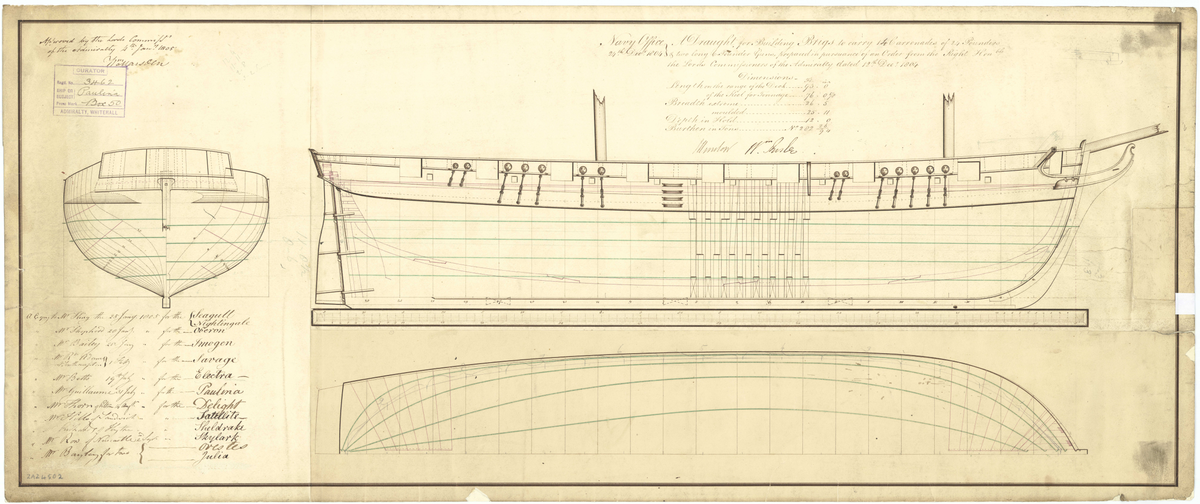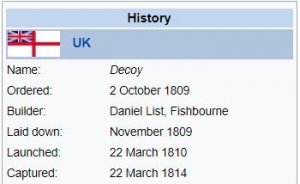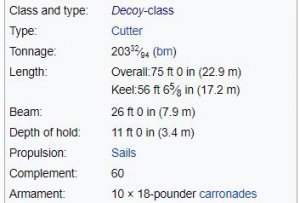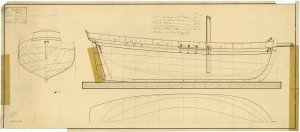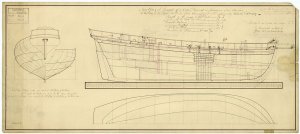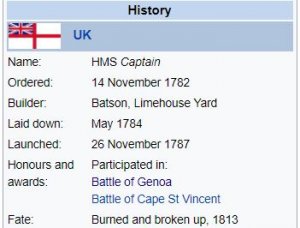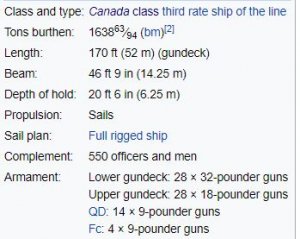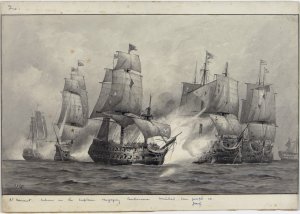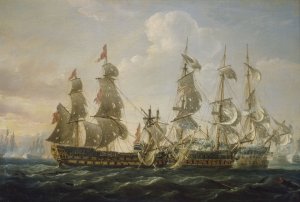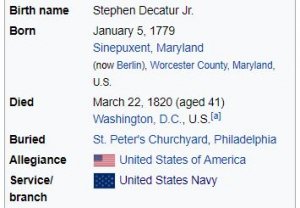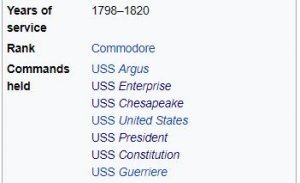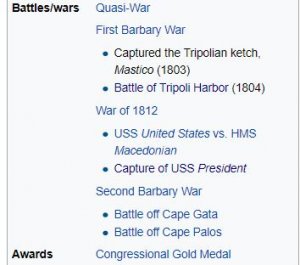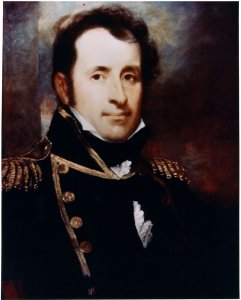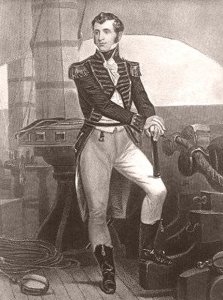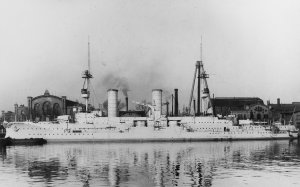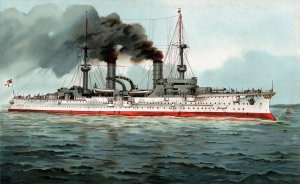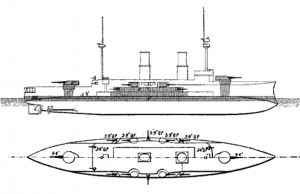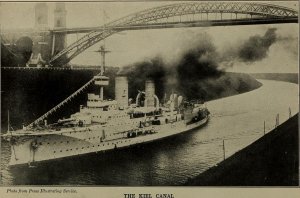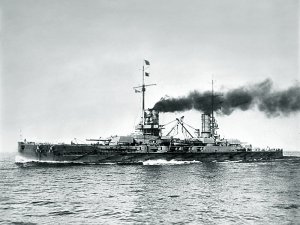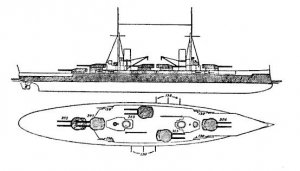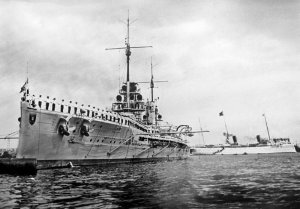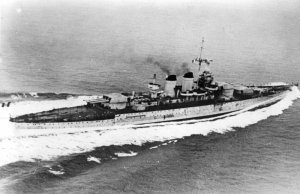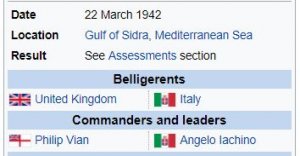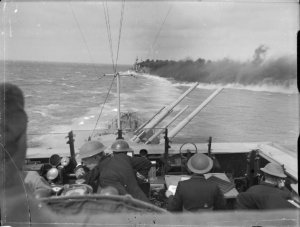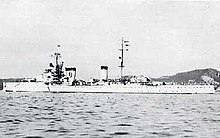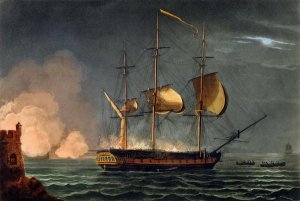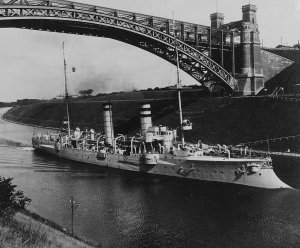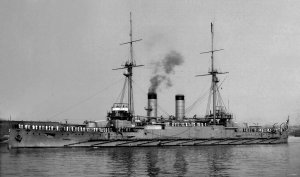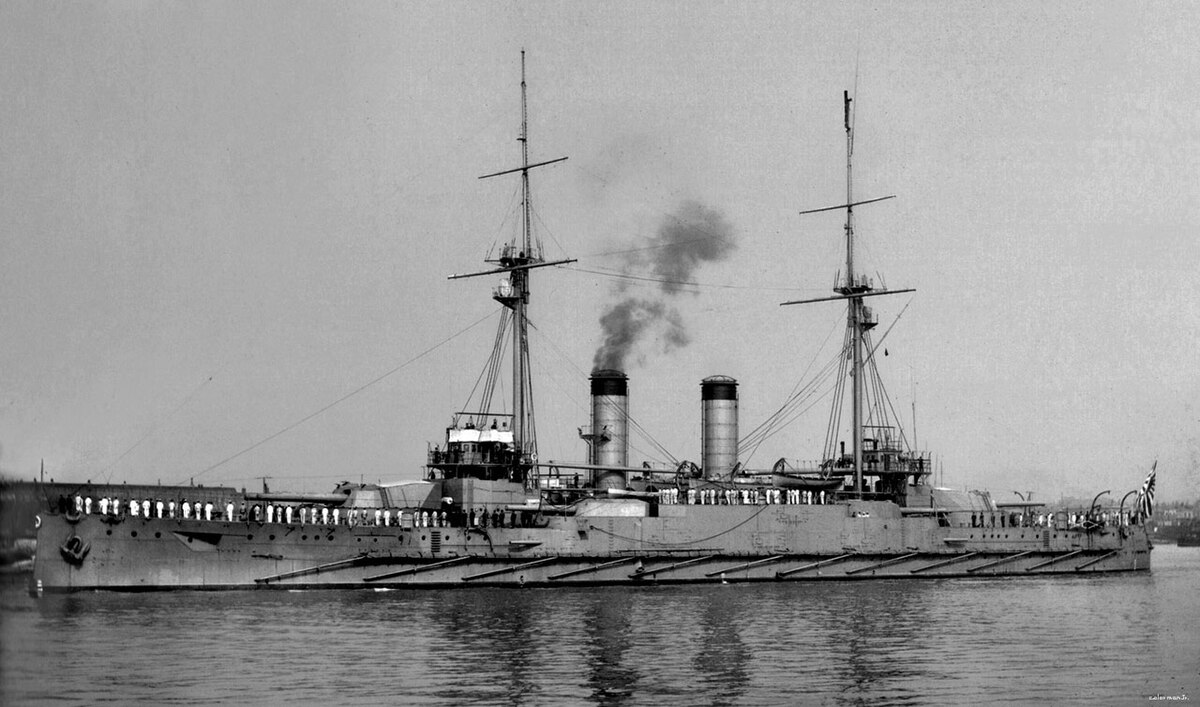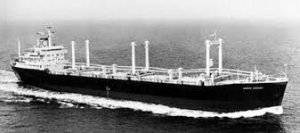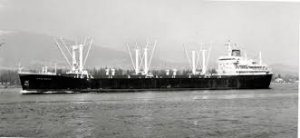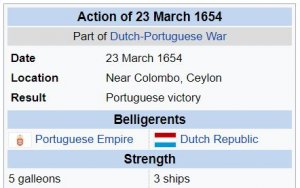Today in Naval History - Naval / Maritime Events in History
21 March 1901 – Launch of HMS Duncan, the lead ship of the six-ship Duncan class of Royal Navy pre-dreadnought battleships.
HMS Duncan was the lead ship of the six-ship Duncan class of Royal Navy pre-dreadnought battleships. Built to counter a group of fast Russian battleships, Duncan and her sister shipswere capable of steaming at 19 knots (35 km/h; 22 mph), making them the fastest battleships in the world. The Duncan-class battleships were armed with a main battery of four 12-inch (305 mm) guns and they were broadly similar to the London-class battleships, though of a slightly reduced displacement and thinner armour layout. As such, they reflected a development of the lighter second-class ships of the Canopus-class battleship. Duncan was built between her keel laying in July 1899 and her completion in October 1903.
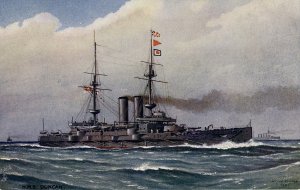
A 1905 postcard depicting HMS Duncan, painting by William Frederick Mitchell
Duncan served with the Mediterranean Fleet until 1905, at which she was transferred to the Channel Fleet. During this period, she was damaged in a pair of accidents, the first a collision with HMS Albion in late 1905 and the second when she ran aground off Lundy Island the following year. Duncan served with the Atlantic Fleet from 1907 to late 1908, when she was transferred back to the Mediterranean Fleet. In 1912, she was transferred to the Home Fleet when the Mediterranean Fleet was reorganized into a squadron of it, and the next year she became a gunnery training ship. After the outbreak of the First World War in August 1914, Duncan was being refitted; once she returned to service in September, she joined her sister ships on the Northern Patrol.
In 1915, Duncan was transferred to the 9th Cruiser Squadron based in the central Atlantic. Later that year, she was reassigned to the 2nd Detached Squadron to support the Italian Royal Navy, and in 1916 she was sent to Salonika, Greece. There, she took part in operations against Greek royalists who opposed entering the war on the side of the Allies. Duncan returned to Britain in February 1917 and was converted into a barracks ship before being broken up for scrap in 1920.
Design
Main article: Duncan-class battleship
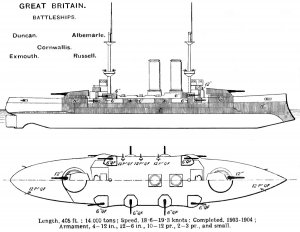
Right elevation and deck plan as depicted in Brassey's Naval Annual 1915
The six ships of the Duncan class were ordered in response to the Russian Peresvet-class battleships that had been launched in 1898. The Russian ships were fast second-class battleships, so William Henry White, the British Director of Naval Construction, designed the Duncan class to match the purported top speed of the Russian vessels. To achieve the higher speed while keeping displacement from growing, White was forced to reduce the ships' armour protection significantly, effectively making the ships enlarged and improved versions of the Canopus-class battleships of 1896, rather than derivatives of the more powerful Majestic, Formidable, and London series of first-class battleships. The Duncans proved to be disappointments in service, owing to their reduced defensive characteristics, though they were still markedly superior to the Peresvets they had been built to counter.
Duncan was 432 feet (132 m) long overall, with a beam of 75 ft 6 in (23.01 m) and a draft of 25 ft 9 in (7.85 m). The Duncan-class battleships displaced 13,270 to 13,745 long tons (13,483 to 13,966 t) normally and up to 14,900 to 15,200 long tons (15,100 to 15,400 t) fully loaded. Her crew numbered 720 officers and ratings. The Duncan-class ships were powered by a pair of 4-cylinder triple-expansion engines that drove two screws, with steam provided by twenty-four Belleville boilers. The boilers were trunked into two funnels located amidships. The Duncan-class ships had a top speed of 19 knots (35 km/h; 22 mph) from 18,000 indicated horsepower (13,000 kW). This made Duncan and her sisters the fastest battleships in the world for several years. At a cruising speed of 10 knots (19 km/h; 12 mph), the ship could steam for 6,070 nautical miles (11,240 km; 6,990 mi).
Duncan had four 12-inch (305 mm) 40-calibre guns mounted in twin-gun turrets fore and aft. The ships also mounted twelve 6-inch (152 mm) 45-calibre guns mounted in casemates, in addition to ten 12-pounder 3 in (76 mm) guns and six 3-pounder 47 mm (1.9 in) guns. As was customary for battleships of the period, she was also equipped with four 18-inch (457 mm) torpedo tubes submerged in the hull.
Duncan had an armoured belt that was 7 in (178 mm) thick; the transverse bulkhead on the aft end of the belt was 7 to 11 in (178 to 279 mm) thick. Her main battery turrets' sides were 8 to 10 in (203 to 254 mm) thick, atop 11 in (279 mm) barbettes, and the casemate battery was protected with 6 in of Krupp steel. Her conning tower had 12-inch-thick sides. She was fitted with two armoured decks, 1 and 2 in (25 and 51 mm) thick, respectively.
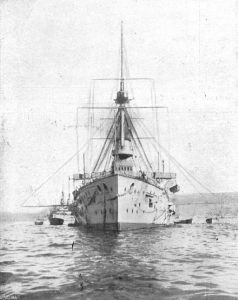
HMS Duncan in 1914
The Duncan class was a class of six pre-dreadnought battleships built for the Royal Navy in the early 1900s. The six ships—HMS Duncan, HMS Albemarle, HMS Cornwallis, HMS Exmouth, HMS Montagu, and HMS Russell—were ordered in response to Russian naval building, specifically the fast second-class battleships of the Peresvet class, which they were specifically to counter. The foremost design consideration was a high top speed to match the rumoured (and incorrect) top speed of 19 knots (35 km/h; 22 mph) of the Russian ships while maintaining the same battery of 12-inch (300 mm) guns and keeping displacement from growing. This forced significant compromises in armour protection, though the ships adopted a revised system of protection for the bow, which was copied in other designs like the London class.
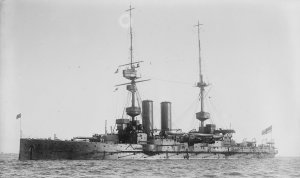
HMS Albemarle
All members of the class served in the Mediterranean Fleet after completion, thereafter joining the Home, Channel, and Atlantic Fleets over the next ten years. In 1906, Montagu was wrecked off Lundy Island and could not be salvaged. The period passed largely uneventfully for the other members of the class. Following the outbreak of the First World War in August 1914, the ships were sent to reinforce the Grand Fleet, where they were used on the Northern Patrol to help blockade Germany. In November, Russell and Exmouth bombarded Zeebrugge, but otherwise the Duncans saw no action in the first months of the war.
Cornwallis participated in the Dardanelles campaign beginning in early 1915, and most of the other members of the class joined her there over the course of the year. Duncan instead served in the Atlantic and later in the Adriatic Sea and Albemarle remained with the Grand Fleet and later went to Murmansk, Russia, to guard the port. Russell and Cornwallis were sunk by German U-boats in April 1916 and January 1917, respectively. The three surviving members of the class saw little activity in the final two years of the war, though Duncan and Exmouth were involved in the Allied intervention in Greece. All three ships were ultimately sold for scrap in the immediate post-war reduction in naval strength and were broken up in 1920.
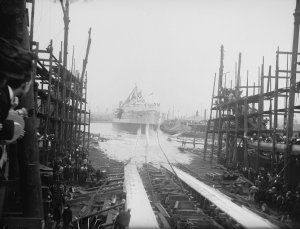
Launch of Cornwallis, 17 July 1901

https://en.wikipedia.org/wiki/HMS_Duncan_(1901)

 en.wikipedia.org
en.wikipedia.org
21 March 1901 – Launch of HMS Duncan, the lead ship of the six-ship Duncan class of Royal Navy pre-dreadnought battleships.
HMS Duncan was the lead ship of the six-ship Duncan class of Royal Navy pre-dreadnought battleships. Built to counter a group of fast Russian battleships, Duncan and her sister shipswere capable of steaming at 19 knots (35 km/h; 22 mph), making them the fastest battleships in the world. The Duncan-class battleships were armed with a main battery of four 12-inch (305 mm) guns and they were broadly similar to the London-class battleships, though of a slightly reduced displacement and thinner armour layout. As such, they reflected a development of the lighter second-class ships of the Canopus-class battleship. Duncan was built between her keel laying in July 1899 and her completion in October 1903.

A 1905 postcard depicting HMS Duncan, painting by William Frederick Mitchell
Duncan served with the Mediterranean Fleet until 1905, at which she was transferred to the Channel Fleet. During this period, she was damaged in a pair of accidents, the first a collision with HMS Albion in late 1905 and the second when she ran aground off Lundy Island the following year. Duncan served with the Atlantic Fleet from 1907 to late 1908, when she was transferred back to the Mediterranean Fleet. In 1912, she was transferred to the Home Fleet when the Mediterranean Fleet was reorganized into a squadron of it, and the next year she became a gunnery training ship. After the outbreak of the First World War in August 1914, Duncan was being refitted; once she returned to service in September, she joined her sister ships on the Northern Patrol.
In 1915, Duncan was transferred to the 9th Cruiser Squadron based in the central Atlantic. Later that year, she was reassigned to the 2nd Detached Squadron to support the Italian Royal Navy, and in 1916 she was sent to Salonika, Greece. There, she took part in operations against Greek royalists who opposed entering the war on the side of the Allies. Duncan returned to Britain in February 1917 and was converted into a barracks ship before being broken up for scrap in 1920.
Design
Main article: Duncan-class battleship

Right elevation and deck plan as depicted in Brassey's Naval Annual 1915
The six ships of the Duncan class were ordered in response to the Russian Peresvet-class battleships that had been launched in 1898. The Russian ships were fast second-class battleships, so William Henry White, the British Director of Naval Construction, designed the Duncan class to match the purported top speed of the Russian vessels. To achieve the higher speed while keeping displacement from growing, White was forced to reduce the ships' armour protection significantly, effectively making the ships enlarged and improved versions of the Canopus-class battleships of 1896, rather than derivatives of the more powerful Majestic, Formidable, and London series of first-class battleships. The Duncans proved to be disappointments in service, owing to their reduced defensive characteristics, though they were still markedly superior to the Peresvets they had been built to counter.
Duncan was 432 feet (132 m) long overall, with a beam of 75 ft 6 in (23.01 m) and a draft of 25 ft 9 in (7.85 m). The Duncan-class battleships displaced 13,270 to 13,745 long tons (13,483 to 13,966 t) normally and up to 14,900 to 15,200 long tons (15,100 to 15,400 t) fully loaded. Her crew numbered 720 officers and ratings. The Duncan-class ships were powered by a pair of 4-cylinder triple-expansion engines that drove two screws, with steam provided by twenty-four Belleville boilers. The boilers were trunked into two funnels located amidships. The Duncan-class ships had a top speed of 19 knots (35 km/h; 22 mph) from 18,000 indicated horsepower (13,000 kW). This made Duncan and her sisters the fastest battleships in the world for several years. At a cruising speed of 10 knots (19 km/h; 12 mph), the ship could steam for 6,070 nautical miles (11,240 km; 6,990 mi).
Duncan had four 12-inch (305 mm) 40-calibre guns mounted in twin-gun turrets fore and aft. The ships also mounted twelve 6-inch (152 mm) 45-calibre guns mounted in casemates, in addition to ten 12-pounder 3 in (76 mm) guns and six 3-pounder 47 mm (1.9 in) guns. As was customary for battleships of the period, she was also equipped with four 18-inch (457 mm) torpedo tubes submerged in the hull.
Duncan had an armoured belt that was 7 in (178 mm) thick; the transverse bulkhead on the aft end of the belt was 7 to 11 in (178 to 279 mm) thick. Her main battery turrets' sides were 8 to 10 in (203 to 254 mm) thick, atop 11 in (279 mm) barbettes, and the casemate battery was protected with 6 in of Krupp steel. Her conning tower had 12-inch-thick sides. She was fitted with two armoured decks, 1 and 2 in (25 and 51 mm) thick, respectively.

HMS Duncan in 1914
The Duncan class was a class of six pre-dreadnought battleships built for the Royal Navy in the early 1900s. The six ships—HMS Duncan, HMS Albemarle, HMS Cornwallis, HMS Exmouth, HMS Montagu, and HMS Russell—were ordered in response to Russian naval building, specifically the fast second-class battleships of the Peresvet class, which they were specifically to counter. The foremost design consideration was a high top speed to match the rumoured (and incorrect) top speed of 19 knots (35 km/h; 22 mph) of the Russian ships while maintaining the same battery of 12-inch (300 mm) guns and keeping displacement from growing. This forced significant compromises in armour protection, though the ships adopted a revised system of protection for the bow, which was copied in other designs like the London class.

HMS Albemarle
All members of the class served in the Mediterranean Fleet after completion, thereafter joining the Home, Channel, and Atlantic Fleets over the next ten years. In 1906, Montagu was wrecked off Lundy Island and could not be salvaged. The period passed largely uneventfully for the other members of the class. Following the outbreak of the First World War in August 1914, the ships were sent to reinforce the Grand Fleet, where they were used on the Northern Patrol to help blockade Germany. In November, Russell and Exmouth bombarded Zeebrugge, but otherwise the Duncans saw no action in the first months of the war.
Cornwallis participated in the Dardanelles campaign beginning in early 1915, and most of the other members of the class joined her there over the course of the year. Duncan instead served in the Atlantic and later in the Adriatic Sea and Albemarle remained with the Grand Fleet and later went to Murmansk, Russia, to guard the port. Russell and Cornwallis were sunk by German U-boats in April 1916 and January 1917, respectively. The three surviving members of the class saw little activity in the final two years of the war, though Duncan and Exmouth were involved in the Allied intervention in Greece. All three ships were ultimately sold for scrap in the immediate post-war reduction in naval strength and were broken up in 1920.

Launch of Cornwallis, 17 July 1901

https://en.wikipedia.org/wiki/HMS_Duncan_(1901)





